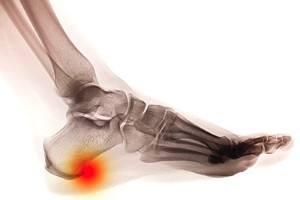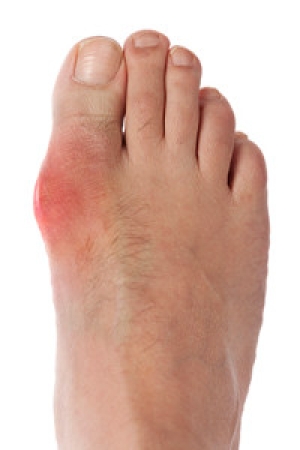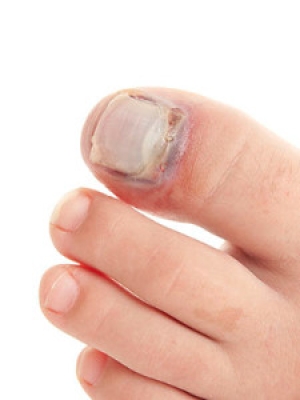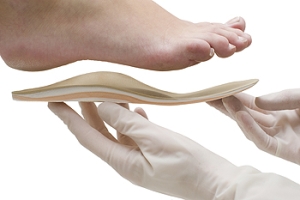
How Do Heel Spurs Develop?
 A heel spur is a regeneration of a bone that forms on the sole of the foot. Additionally, the development of this ailment can appear in the area where the Achilles tendon connects to the heel and may produce severe pain. In most cases, a heel spur will gradually develop, and is often caused by strain experienced by the muscles and ligaments. Causes of this type of discomfort may originate from shoes that fit incorrectly, additional body weight the feet must endure, or an injury that caused the heel to bruise. Paying close attention to the general health of the feet may be a successful prevention technique for heel spurs. This may include noticing any type of aches and pain that may appear, especially on the sole of the foot. Moderate relief may be obtained from resting the foot in addition to performing gentle stretching exercises. It’s suggested to consult with a podiatrist for treatment options for heel spurs, which may include surgery.
A heel spur is a regeneration of a bone that forms on the sole of the foot. Additionally, the development of this ailment can appear in the area where the Achilles tendon connects to the heel and may produce severe pain. In most cases, a heel spur will gradually develop, and is often caused by strain experienced by the muscles and ligaments. Causes of this type of discomfort may originate from shoes that fit incorrectly, additional body weight the feet must endure, or an injury that caused the heel to bruise. Paying close attention to the general health of the feet may be a successful prevention technique for heel spurs. This may include noticing any type of aches and pain that may appear, especially on the sole of the foot. Moderate relief may be obtained from resting the foot in addition to performing gentle stretching exercises. It’s suggested to consult with a podiatrist for treatment options for heel spurs, which may include surgery.
Heel spurs can be incredibly painful and sometimes may make you unable to participate in physical activities. To get medical care for your heel spurs, contact Dr. Michael A. Wood from Foot Health Institute. Our doctor will do everything possible to treat your condition.
Heels Spurs
Heel spurs are formed by calcium deposits on the back of the foot where the heel is. This can also be caused by small fragments of bone breaking off one section of the foot, attaching onto the back of the foot. Heel spurs can also be bone growth on the back of the foot and may grow in the direction of the arch of the foot.
Older individuals usually suffer from heel spurs and pain sometimes intensifies with age. One of the main condition's spurs are related to is plantar fasciitis.
Pain
The pain associated with spurs is often because of weight placed on the feet. When someone is walking, their entire weight is concentrated on the feet. Bone spurs then have the tendency to affect other bones and tissues around the foot. As the pain continues, the feet will become tender and sensitive over time.
Treatments
There are many ways to treat heel spurs. If one is suffering from heel spurs in conjunction with pain, there are several methods for healing. Medication, surgery, and herbal care are some options.
If you have any questions feel free to contact one of our offices located in Lansing, and Chicago, IL . We offer the latest in diagnostic and treatment technology to meet your needs.
Heel Spurs
Heel spurs are the result of calcium deposits that cause bony protrusions on the underside of the heel. Heel spurs are usually painless, but they have the potential to cause heel pain. Heel spurs tend to be associated with plantar fasciitis, which is a condition that causes inflammation of the band of connective tissue that runs along the bottom of the foot. They most often occur to athletes whose sports involve a lot of running and jumping.
Some risk factors for developing heel spurs include running and jogging on hard surfaces, being obese, wearing poorly fitting shoes, or having walking gait abnormalities.
It is possible to have a heel spur without showing signs of any symptoms. However, if inflammation develops at the point of the spur’s formation, you may have pain while walking or running. In terms of diagnosis, sometimes all a doctor needs to know is that the patient is experiencing a sharp pain localized to the heel to diagnose a heel spur. Other times, an x-ray may be needed to confirm the presence of a heel spur.
Heel spurs can be prevented by wearing well-fitting shoes that have shock-absorbent soles. You should also be sure that you are choosing the right shoe for the activity you want to partake in; for example, do not wear walking shoes when you want to go on a run. Additionally, maintaining a healthy weight can be beneficial toward preventing heel spurs, as it will prevent an excess amount of pressure being placed on the ligaments.
There are a variety of treatment options for people with heel spurs. Some of these include stretching exercises, physical therapy, shoe inserts, or taping and strapping to rest stressed muscles and tendons. If you have heel pain that lasts longer than a month, don’t hesitate to seek help from a podiatrist. Your doctor can help you determine which treatment option is best for you.
Symptoms and Causes of Gout
 If you are experiencing severe pain in the joints surrounding the big toe, you may have a condition referred to as gout. It’s considered to be a form of arthritis, and the symptoms include redness, swelling, and extreme tenderness. Gout is the result of a buildup of excess uric acid in the body, and typically collects in the joints of the foot. These bouts of pain are typically known as gout attacks, and there may be several reasons for this to develop. The most common theory revolves around the food and drink that is consumed, which typically involves the frequent ingestion of red meat and excess alcohol. Additionally, inherited genetic traits may be a determining factor in the onset of gout. It’s important to consider scheduling a consultation with a podiatrist to learn about proper treatment options for gout.
If you are experiencing severe pain in the joints surrounding the big toe, you may have a condition referred to as gout. It’s considered to be a form of arthritis, and the symptoms include redness, swelling, and extreme tenderness. Gout is the result of a buildup of excess uric acid in the body, and typically collects in the joints of the foot. These bouts of pain are typically known as gout attacks, and there may be several reasons for this to develop. The most common theory revolves around the food and drink that is consumed, which typically involves the frequent ingestion of red meat and excess alcohol. Additionally, inherited genetic traits may be a determining factor in the onset of gout. It’s important to consider scheduling a consultation with a podiatrist to learn about proper treatment options for gout.
Gout is a foot condition that requires certain treatment and care. If you are seeking treatment, contact Dr. Michael A. Wood from Foot Health Institute. Our doctor will treat your foot and ankle needs.
What Is Gout?
Gout is a type of arthritis caused by a buildup of uric acid in the bloodstream. It often develops in the foot, especially the big toe area, although it can manifest in other parts of the body as well. Gout can make walking and standing very painful and is especially common in diabetics and the obese.
People typically get gout because of a poor diet. Genetic predisposition is also a factor. The children of parents who have had gout frequently have a chance of developing it themselves.
Gout can easily be identified by redness and inflammation of the big toe and the surrounding areas of the foot. Other symptoms include extreme fatigue, joint pain, and running high fevers. Sometimes corticosteroid drugs can be prescribed to treat gout, but the best way to combat this disease is to get more exercise and eat a better diet.
If you have any questions please feel free to contact one of our offices located in Lansing, and Chicago, IL . We offer the newest diagnostic and treatment technologies for all your foot and ankle needs.
Everything You Need to Know About Gout
Gout, typically found in diabetic patients, is an unusually painful form of arthritis caused by elevated levels of uric acid in the bloodstream. The condition typically strikes the big joint on the big toe. It has also been known to strike the knees, elbows, fingers, ankles and wrists—generally anywhere that has a functioning, moving joint.
The high level of uric acid in a person’s bloodstream creates the condition known as hyperuricema—the main cause of gout. Genetic predisposition occurs in nine out of ten sufferers. The children of parents who suffer gout will have a two in ten chance of developing the condition as well.
This form of arthritis, being particularly painful, is the leftover uric acid crystallizing in the blood stream. The crystallized uric acid then travels to the space between joints where they rub, causing friction when the patient moves. Symptoms include: pain, redness, swelling, and inflammation. Additional side effects may include fatigue and fever, although reports of these effects are very rare. Some patients have reported that pain may intensify when the temperature drops, such as when you sleep.
Most cases of gout are easily diagnosed by a podiatrist’s assessment of the various symptoms. Defined tests can also be performed. A blood test to detect elevated levels of uric acid is often used as well as an x-ray to diagnose visible and chronic gout.
Treatment for gout simply means eliminating symptoms. Non-steroid anti-inflammatory drugs or NSAIDs (Colchicine and other corticosteroid drugs, etc.) will quell the redness, the swelling, and the inflammation. However, managing your diet, lifestyle changes, and using preventative drugs are all helpful toward fully combating the most severe cases.
Those that lead an inactive lifestyle are at a higher risk for gout. Any amount of exercise decreases the probability of repeat encounters with the condition. Reducing your consumption of red meat, sea food, and fructose-sweetened drinks also reduces the likelihood of chronic gout as well.
Ingesting Vitamin C, coffee, and particular dairy products can help with maintaining a healthy lifestyle. There are new drugs out on the market that inhibit the body’s production of uric acid-producing enzymes. However, reducing or eliminating your overall levels of uric acid is the best remedy to ensuring you lead a gout-free life.
Symptoms of a Broken Toe
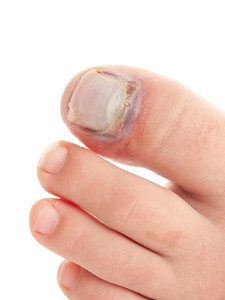 If you have the experience of something heavy falling on your foot, you may have what is referred to as a broken toe. Common signs from this occurring will be swelling and bruising affecting the toe and surrounding area, accompanied by severe pain. If the bone protrudes from the skin, this is typically known as an extreme fracture, and medical attention should be sought as soon as possible for treatment. If the break is not severe, the toe will benefit from being elevated, which may aid in reducing any obvious swelling. A common treatment technique involves bandaging the injured toe to the toe next to it, and this may promote stability and proper healing. It may be suggested to wear comfortable shoes with adequate room for the toes, and the use of crutches may be beneficial in keeping weight off the foot. If you feel you may have broken your toe, see a podiatrist immediately for a proper diagnosis and additional information.
If you have the experience of something heavy falling on your foot, you may have what is referred to as a broken toe. Common signs from this occurring will be swelling and bruising affecting the toe and surrounding area, accompanied by severe pain. If the bone protrudes from the skin, this is typically known as an extreme fracture, and medical attention should be sought as soon as possible for treatment. If the break is not severe, the toe will benefit from being elevated, which may aid in reducing any obvious swelling. A common treatment technique involves bandaging the injured toe to the toe next to it, and this may promote stability and proper healing. It may be suggested to wear comfortable shoes with adequate room for the toes, and the use of crutches may be beneficial in keeping weight off the foot. If you feel you may have broken your toe, see a podiatrist immediately for a proper diagnosis and additional information.
A broken toe can be very painful and lead to complications if not properly fixed. If you have any concerns about your feet, contact Dr. Michael A. Wood from Foot Health Institute. Our doctor will treat your foot and ankle needs.
What to Know About a Broken Toe
Although most people try to avoid foot trauma such as banging, stubbing, or dropping heavy objects on their feet, the unfortunate fact is that it is a common occurrence. Given the fact that toes are positioned in front of the feet, they typically sustain the brunt of such trauma. When trauma occurs to a toe, the result can be a painful break (fracture).
Symptoms of a Broken Toe
- Throbbing pain
- Swelling
- Bruising on the skin and toenail
- The inability to move the toe
- Toe appears crooked or disfigured
- Tingling or numbness in the toe
Generally, it is best to stay off of the injured toe with the affected foot elevated.
Severe toe fractures may be treated with a splint, cast, and in some cases, minor surgery. Due to its position and the pressure it endures with daily activity, future complications can occur if the big toe is not properly treated.
If you have any questions please feel free to contact one of our offices located in Lansing, and Chicago, IL . We offer the newest diagnostic and treatment technologies for all your foot and ankle needs.
What to Know About a Broken Toe
Trauma to the foot, especially the toes, can occur in many ways. Banging them, stubbing them, or dropping something on them are a few different ways this trauma can occur. Given the fact that toes are positioned in front of the feet, they typically sustain the brunt of such trauma. When trauma occurs to a toe, the result can be a painful break or fracture. Another type of trauma that can break a toe is repeated activity that places stress on the toe for prolonged periods of time.
Broken toes can be categorized as either minor or severe fractures. Symptoms of minor toe fractures include throbbing pain, swelling, bruising on the skin and toenail, and the inability to move the toe with ease. Severe toe fractures require medical attention and are indicated when the broken toe appears crooked or disfigured, when there is tingling or numbness in the toe, or when there is an open, bleeding wound present on the toe.
Generally, a minor toe break will heal without long-term complications. However, it is important to discontinue activities that put pressure on the toe. It is best to stay off of the injured toe and immediately get a splint or cast to prevent any more additional movement of the toe bones. You can also immobilize your toe by placing a small cotton ball between the injured toe and the toe beside it. Then, tape the two toes together with medical tape. Swelling can be alleviated by placing an ice pack on the broken toe directly as well as elevating your feet above your head.
Severe toe fractures may be treated with a splint, cast, and in some cases, minor surgery, especially when the big toe has been broken. Due to its position and the pressure the big toe endures with daily activity, future complications can occur if it is not properly treated. Pain associated with minor toe fractures can be managed with over-the-counter pain medications. Prescription pain killers may be necessary for severe toe fractures.
The healing time for a broken toe is approximately four to six weeks. In severe cases where the toe becomes infected or requires surgery, healing time can take up to eight weeks or more. While complications associated with a broken toe are immediately apparent, it is important to note that there are rare cases when additional complications, such as osteoarthritis, can develop over time. You should immediately speak with your podiatrist if you think you have broken your toe due to trauma. They will be able to diagnose the injury and recommend the appropriate treatment options.
Surgery for Bunions
 If you experience a bony growth on the side of the big toe, you may have what is referred to as a bunion. This condition may require surgery to be performed, which will generally provide permanent relief. This surgical procedure typically involves removal of the bony protrusion or possibly a restructuring of the toes, which will depend on the severity of the bunion. Surgery will involve undergoing general or local anesthesia, which is determined based on each individual. There may be several ways to perform this type of operation, and it can typically depend on other factors involving the foot, such as any arthritis that may be present. Recovery includes utilizing a bandage or splint so the foot is protected and can rest comfortably. Crutches may be beneficial to use, which can aid in keeping weight off the toe. If you have a bunion and would like additional information about how surgery can be effective for you, please schedule a consultation with a podiatrist.
If you experience a bony growth on the side of the big toe, you may have what is referred to as a bunion. This condition may require surgery to be performed, which will generally provide permanent relief. This surgical procedure typically involves removal of the bony protrusion or possibly a restructuring of the toes, which will depend on the severity of the bunion. Surgery will involve undergoing general or local anesthesia, which is determined based on each individual. There may be several ways to perform this type of operation, and it can typically depend on other factors involving the foot, such as any arthritis that may be present. Recovery includes utilizing a bandage or splint so the foot is protected and can rest comfortably. Crutches may be beneficial to use, which can aid in keeping weight off the toe. If you have a bunion and would like additional information about how surgery can be effective for you, please schedule a consultation with a podiatrist.
Foot surgery is sometimes necessary to treat a foot ailment. To learn more, contact Dr. Michael A. Wood of Foot Health Institute. Our doctor will assist you with all of your foot and ankle needs.
When Is Surgery Necessary?
Foot and ankle surgery is generally reserved for cases in which less invasive, conservative procedures have failed to alleviate the problem. Some of the cases in which surgery may be necessary include:
- Removing foot deformities like bunions and bone spurs
- Severe arthritis that has caused bone issues
- Cosmetic reconstruction
What Types of Surgery Are There?
The type of surgery you receive will depend on the nature of the problem you have. Some of the possible surgeries include:
- Bunionectomy for painful bunions
- Surgical fusion for realignment of bones
- Neuropathy decompression surgery to treat nerve damage
Benefits of Surgery
Although surgery is usually a last resort, it can provide more complete pain relief compared to non-surgical methods and may allow you to finally resume full activity.
Surgical techniques have also become increasingly sophisticated. Techniques like endoscopic surgery allow for smaller incisions and faster recovery times.
If you have any questions please feel free to contact one of our offices located in Lansing, and Chicago, IL . We offer the newest diagnostic and treatment technologies for all your foot and ankle needs.
Foot Surgery
In most cases, foot surgery is often chosen as the last available option for conditions that have otherwise been unsuccessfully treated. Surgery may be necessary for several reasons, including the removal of foot deformities (e.g. bone spurs or bunions), arthritis problems, reconstruction due to injury, and congenital malformations (e.g. club foot or flat feet). Regardless of one’s age, foot surgery may be the only successful option for treatment for certain conditions.
The type of surgery one undergoes depends on the type of foot condition the patient has. For the removal of a bunion growth, a bunionectomy is necessary. If the bones in the feet need to be realigned or fused together, a surgical fusion of the foot is needed. For pain or nerve issues, a patient may require surgery in which the tissues surrounding the painful nerve are removed. Initially, less invasive treatments are generally attempted; surgery is often the last measure taken if other treatments are unsuccessful.
While in many cases surgery is often deemed as the final resort, choosing surgery comes with certain benefits. The associated pain experienced in relation to the particular condition is often relieved with surgery, allowing patients to quickly resume daily activities. The greatest benefit, however, is that surgery generally eliminates the problem immediately.
Podiatry history has shown that foot treatments continue to evolve over time. In the field of foot surgery, endoscopic surgery is just one of the many advanced forms of surgery. As technology vastly improves so too will the various techniques in foot surgery, which already require smaller and smaller incisions with the use of better and more efficient tools. Thanks to such innovations, surgery is no longer as invasive as it was in the past, allowing for faster and easier recoveries.
What are Orthotics?
 Corrective inserts that are designed to be used in shoes are often referred to as orthotics. There are several benefits to using orthotics, including providing comfort, stability, and additional support that the foot may need. They are typically used to correct certain foot abnormalities, including high arches, flat feet, or foot structures that may originate from a predisposed inherited gene. They are generally constructed of materials designed for the specific foot issue, which may be a high arch or specific heel injuries. If you have foot pain, there is a chance that orthotics may work for you. A podiatrist will be able to ascertain if orthotics are needed for your foot condition.
Corrective inserts that are designed to be used in shoes are often referred to as orthotics. There are several benefits to using orthotics, including providing comfort, stability, and additional support that the foot may need. They are typically used to correct certain foot abnormalities, including high arches, flat feet, or foot structures that may originate from a predisposed inherited gene. They are generally constructed of materials designed for the specific foot issue, which may be a high arch or specific heel injuries. If you have foot pain, there is a chance that orthotics may work for you. A podiatrist will be able to ascertain if orthotics are needed for your foot condition.
If you are having discomfort in your feet and would like to try orthotics, contact Dr. Michael A. Wood from Foot Health Institute. Our doctor can provide the care you need to keep you pain-free and on your feet.
What Are Orthotics?
Orthotics are inserts you can place into your shoes to help with a variety of foot problems such as flat feet or foot pain. Orthotics provide relief and comfort for minor foot and heel pain but can’t correct serious biomechanical problems in your feet.
Over-the-Counter Inserts
Orthotics come in a wide variety of over-the-counter inserts that are used to treat foot pain, heel pain, and minor problems. For example, arch supports can be inserted into your shoes to help correct overarched or flat feet, while gel insoles are often used because they provide comfort and relief from foot and heel pain by alleviating pressure.
Prescription Orthotics
If over-the-counter inserts don’t work for you or if you have a more severe foot concern, it is possible to have your podiatrist prescribe custom orthotics. These high-quality inserts are designed to treat problems such as abnormal motion, plantar fasciitis, and severe forms of heel pain. They can even be used to help patients suffering from diabetes by treating foot ulcers and painful calluses and are usually molded to your feet individually, which allows them to provide full support and comfort.
If you are experiencing minor to severe foot or heel pain, it’s recommended to speak with your podiatrist about the possibilities of using orthotics. A podiatrist can determine which type of orthotic is right for you and allow you to take the first steps towards being pain-free.
If you have any questions please contact one of our offices located in Lansing, and Chicago, IL . We offer the newest diagnostic and treatment technologies for all your foot and ankle needs.
Foot Orthotics
Orthotics are shoe inserts that are meant to correct an irregular walking gait or provide cushioning to the feet. Orthotics come in a variety of different models and sizes, including over-the-counter and customizable variants. Customizable orthotics can be shaped and contoured to fit inside a specific shoe and are typically prescribed through a podiatrist who specializes in customized footwear and orthotics design and management.
Orthotics are beneficial because they can help prevent injuries from occurring and provide cushioning to keep pain levels down to a minimum. They also allow for the correct positioning of the feet. Orthotics can act as shock absorbers to help remove pressure from the foot and ankle. Therefore, orthotics can make bodily movements, such as walking and running, become more comfortable as well as help prevent the development of certain foot conditions.
Orthotics alleviate pain and make the foot more comfortable by slightly altering the angle at which the foot strikes the ground surface, therefore controlling the movement of the foot and ankle. Orthotics come in different variants and can be made of various materials. To determine what type of orthotic is most suited to your feet and your needs, it is best to consult your podiatrist. He or she will be able to recommend a type of orthotic that can help improve your foot function or prescribe a custom orthotic to best fit your feet.
